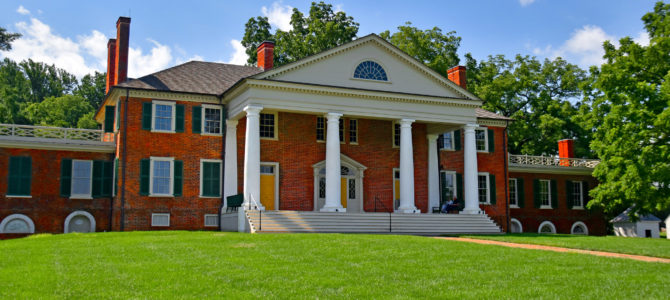
Along with a group of other young professionals, I journeyed to James Madison’s Montpelier last year for a weekend summit “to connect with the source of American democracy.” I was disappointed. It seems the Montpelier Foundation has adopted a version of the “blame America first” mantra: Blame the Founders first, instead.
In June 2017, “The Mere Distinction of Colour” exhibit, composed of three separate exhibits on slavery, opened at Montpelier. An 11-minute video on “slavery’s lasting legacies in modern society” occupies its own room in the cellars.
Professor Hasan Kwame Jeffries, chair of the Teaching Hard History Advisory Board, an initiative of the Southern Poverty Law Center (SPLC), is featured. There are some notable similarities between the video and the preface of SPLC’s report (authored by Jeffries).
The SPLC is now infamous as an ideologically biased organization. They brand conservative nonprofits such as the Alliance Defending Freedom, an institution that has won Supreme Court cases, “hate groups.” Even Twitter is not comfortable relying on the advice of the SPLC, having removed them from their “Trust and Safety Council” recently. Yet their arguments are welcome at Montpelier.
“Teaching Hard History: American Slavery” was published in February 2018. That same month, Montpelier hosted the National Summit on Teaching Slavery. Participants included Jeffries and Director of Teaching Tolerance Maureen Costello.
The Montpelier Foundation’s agenda clearly aligns with the SPLC’s. On their website for the summit, they praise the SPLC report and note that not only does it apply to “the teaching of slavery in America’s schools, it is equally applicable to museums, historic sites, and other cultural institutions.”
Education doesn’t just happen in the classroom. More than 125,000 people visit Montpelier every year to learn about the life and ideas of the “Father of the Constitution.” The Montpelier Foundation and the SPLC are providing a particular rubric for how American history should be taught both in high schools and at historic sites.
Simplistic Answers to Tough Questions
This rubric is on display in the north cellar of Montpelier. The exhibit seeks to explain the contradiction between the Constitution, the principles of liberty, and slavery. The answer it provides is greed. There is certainly a lot of truth to this, as profit motivated many slave owners to participate in the horrific institution. But it is a partial truth; it is not the whole story of Montpelier or America, and as such, it is not a fair story.
The exhibit makes little mention of the political challenges and prudential choices the Founders faced in eradicating slavery. A display on the Three-Fifths Compromise reads that the delegates to the Constitutional Convention “protected” southern interests and “appeased” northern states. It would be more accurate to say the reverse. The Founders sought to set slavery on the “course of ultimate extinction” though they were unable to eradicate it in their lifetimes.
At the Convention, the most notable divide was between North and South. The looming threat was that the South would secede and form their own country (as they later did). If that had happened, the anti-slavery North would not have been able to exert its influence on the South. Then arguably very few, if any, slaves would have been freed. Forming the union was the best hope of ending slavery.
The exhibit endeavors to paint the Constitution as a pro-slavery document. Most would identify the Three-Fifths and fugitive slave clauses as those pertaining to slavery. But the Montpelier Foundation goes further, arguing that slavery seeps into the clauses pertaining to protections against invasions and insurrections and the Electoral College.
The delegates saw the slavery clauses as necessary compromises the Constitution would one day be able to shed. They marked an end date for the slave trade. And they refrained from using the words “slave” or “slavery” in the Constitution. Madison “thought it wrong to admit in the Constitution the idea that there could be property in men.” Abraham Lincoln echoed this sentiment. Their arguments, and that of Frederick Douglass, who observed that the Founding government was “never, in its essence, anything but an anti-slavery government” should have a voice at Montpelier.
Judging Everyone by Today’s Standards
Instead, the exhibit condemns all those who lived during the Founding period en masse. A “Slavery and the Presidency” display pictures the first 18 presidents and describes their relationships with slavery.
Even those who never owned slaves, such as John Adams, are implicated. For, “some of his legal clients did, including John Hancock. Adams’s wife Abigail grew up in a Massachusetts family that enslaved two people, Pheby and Tom.” Now, few of us would remain blameless if we were held accountable for the misdeeds of our business associates and distant family members.
Several of the descriptions include how many slaves a given president owned and freed. The note for Washington ends, “At his death, Washington owned or controlled 318 people.” Period. They could have continued: Washington freed all his slaves on the death of his wife, and his estate provided for the care of the old and infirm and education of the young.
It is important that we have conversations about the Founders and slavery. When we do, we should consider all the relevant facts and information.
Without the Constitution, We’re Done For
So why would the Montpelier Foundation choose to present Madison and the Founding in such a manner? One answer is this: Madison’s achievements are America’s achievements. Madison served at the Constitutional Convention, and his Federalist essays helped ensure the document’s ratification. He is most responsible for the Bill of Rights. And he was an ardent advocate of freedom of conscience.
The Constitution, the Bill of Rights, and freedom of conscience are all essential to America’s character. They are her accomplishments and have formed her people. If you can successfully blame Madison, you can blame America.
Jeffries asserts that America’s failures continue through our history until today: “There are probably more defeats in the pursuit of justice and fairness and equality in American history than there are moments of triumph.” Such an argument goes: America is a failed experiment. She was tainted in her infancy and never able to atone for the original sin of slavery. And if the Constitution itself is an irredeemably flawed document based on false and pro-slavery principles, then it needs to be replaced.









